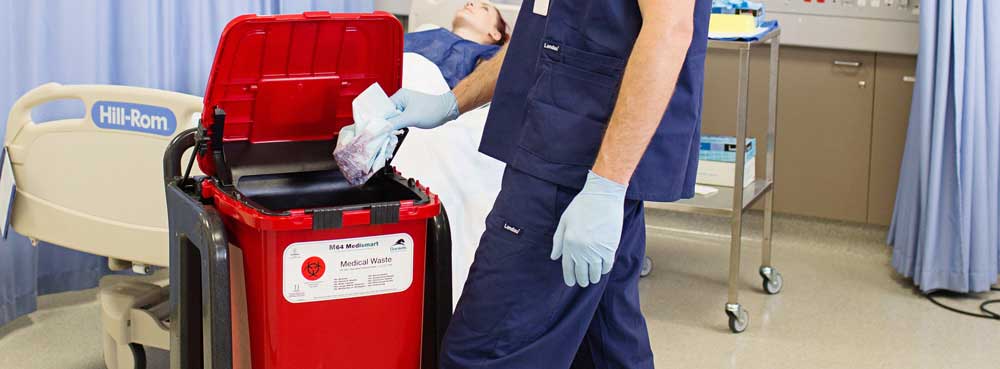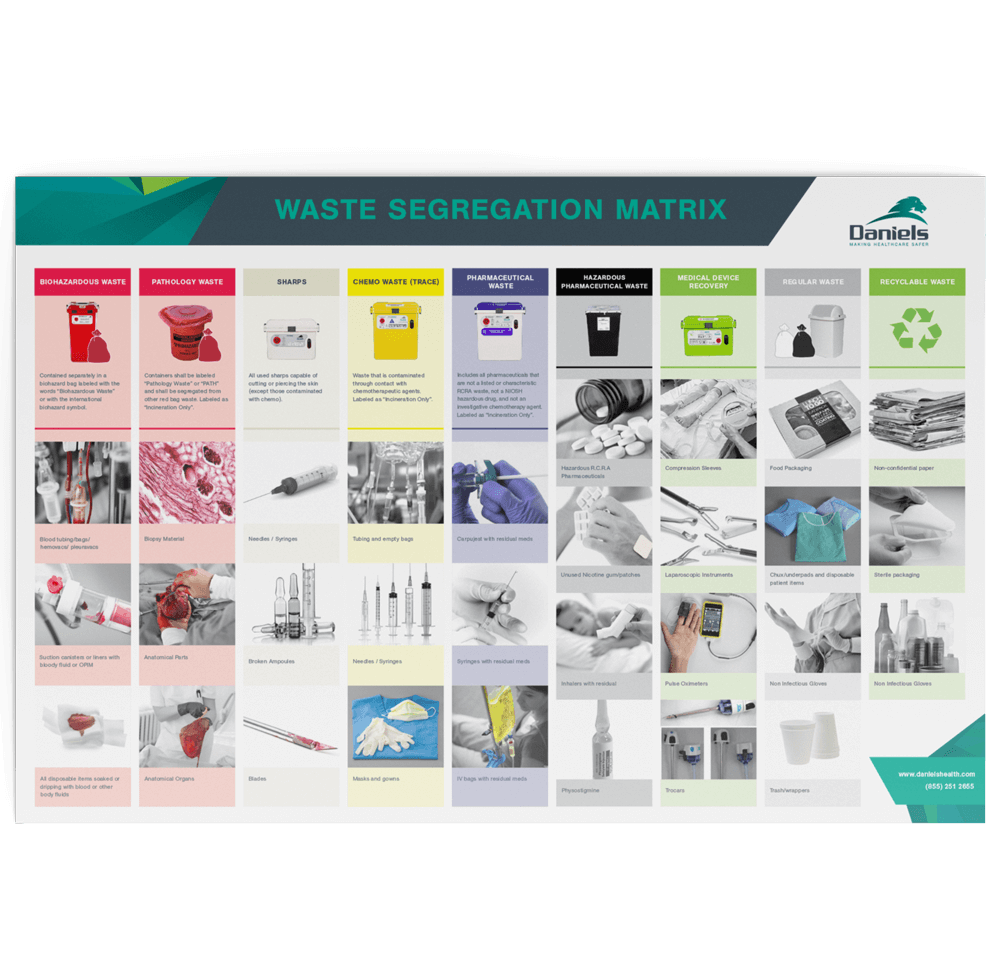Medical Waste 101: What Are the Different Types of Medical Waste?

All healthcare workers will be familiar with the challenge of sorting and disposing of medical waste. This is a task that comes with high stakes. Improper disposal has a variety of consequences, such as increased health risks, like needlestick injury, and a negative environmental impact. At Daniels Health, we endeavor to help healthcare facilities manage their medical waste confidently, compliantly and efficiently.
In this article, we’ll delve into the different types of medical waste and how to keep your employees safe when handling and disposing of it. This information will help you ensure compliant medical waste management in your facility.
CONTENTS
1 / What is Regulated Medical Waste
2 / Responsible Waste Segregation Starts With You
3 / Categories of Medical Waste
5 / Daniels Health: Ensuring Compliance Every Step of the Way
What is Regulated Medical Waste?
Regulated medical waste (RMW) also known as biomedical or biohazardous waste, refers to non-hazardous wastes that are potentially infectious in nature. RMW refers to any waste that could put human health or the environment at risk by spreading harmful microorganisms. The Environmental Protection Agency (EPA) defines RMW as items that have been in contact with blood components, bodily fluids and other potentially infectious materials (OPIM).
RMW poses a risk of infection and the spread of diseases to the handler. Therefore, it must be placed in regulated medical waste containers that comply with government guidelines.
Responsible Waste Segregation Starts With You
Governments and state agencies provide frameworks for proper waste disposal. However, it’s ultimately up to facilities to understand the different types and categories of medical waste.
It’s equally important to stay up to date on government and state definitions and guidelines to ensure compliance.
We recommend implementing engaging training programs on the disposal of medical waste to educate and protect healthcare workers. You can start with our free waste segregation brochure, which outlines the correct containers and contents for regulated medical waste disposal. However, it's extremely important to note that this is a general example of a waste segregation poster. Not only do waste definitions vary by state, but often individual hospitals will have their own definitions of waste streams that go above and beyond state requirements.
Categories of Medical Waste
Medical waste is generally categorized as:
- Regulated medical waste
-
Infectious waste

-
Biohazardous waste
Guidelines will vary from state to state, depending on their definition of “infectious”. Some states will adopt the definitions found in federal guidelines, like those from the EPA, OSHA and DOT. However, it’s important to research your state’s guidelines to ensure compliance.
Navigate our map to better understand the medical waste regulations that govern your state of jurisdiction.
What are the Different Types of Medical Waste?
The EPA specifies several types of regulated medical waste classes. Examples of regulated medical waste include:
- Pathological waste: This consists of liquid and solid waste — bodily fluids and anatomical wastes (human tissues, animal tissues, organs, or body parts) that have been examined in a laboratory or culled from biopsies and surgical procedures.
- Contaminated sharps: This includes needles, broken glass, capillary tubes or scalpel blades contaminated by bloodborne pathogens and OPIM.
- Uncontaminated sharps: This refers to sharp medical instruments like needles and disposable scalpel blades that haven't been exposed to infectious materials. Unlike contaminated sharps, these do not pose a risk of transmitting infections but still require careful handling to prevent injuries.
- Microbiological waste: This refers to waste that contains cultures and stocks of infectious agents, including pathological and pharmaceutical specimens.
- Human and non-human blood products and components: This includes any therapeutic blood specimen used for plasma-derived medicine and transfusion.
-
Isolation waste: This is a form of contaminated biological waste. Such items will generally contain exudates, excretions, blood, body fluids or secretions from humans or animals. More specifically, those infected with pathogenic material.
The EPA categorizes these types of healthcare waste based on the item’s toxic properties and the potential for the item to transmit infection. However, these guidelines may adapt according to advances in technology and scientific developments.
Ensuring Compliance and Safety in Regulated Waste Management
Healthcare facilities need to understand the different types of medical waste and how to categorize them. This helps to ensure safe disposal and handling, protecting healthcare workers and reducing the risk of injury or infection.
Healthcare requires constant education and training to drive safety, compliance and segregations in the workplace. The legal guidelines for medical waste disposal will vary from state to state. Therefore, it’s absolutely crucial for facilities to stay up-to-date with current information in order to avoid fines or penalties.
Daniels Health: Your Partner in Compliance and Efficient Waste Management
Here at Daniels Health, we pride ourselves on being a medical waste disposal company with a difference. We stay up-to-date with all federal and state guidelines to maintain our reputation as an industry leader in waste management.
A Daniels partnership comes with many advantages for your facility’s medical waste management system. These include minimizing waste, providing educational resources and reducing the risk of injury.
We make compliance simple. Our comprehensive online compliance portal offers training, regulation-access and record-keeping resources. Send an email to compliance@danielshealth.com to continue your education.
Let’s Talk!
Your time is valuable, and we don’t want to waste it. We're here to provide whatever information about types of medical waste, medical waste segregation and medical waste disposal you might need. Contact us directly to speak with one of our friendly and professional customer service representatives or fill out this short form for a free quote. Our team will get back to you in no time.
